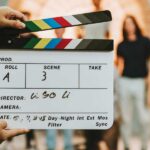
Joker: Folie à Deux
Posted on Nov 16, 2024 by Samara Husbands
Crazy in Love
Lush fantasy sequences, lighting as a character and an ambitious oner: cinematographer Lawrence Sher shares how he crafted the captivating visual world of Joker: Folie à Deux
Words Nicola Foley Images Warner Bros
2019’s Joker defied expectations to become a global sensation. Grossing over $1 billion worldwide, it swept awards season and earned 11 Oscar nominations, ultimately securing wins for best actor and best original score. This DC villain origin story even took home Venice’s Golden Lion, a feat virtually unheard of for a major Hollywood studio release – never mind a comic book adaptation.
It’s fair to say that its follow-up Joker: Folie à Deux has polarised opinion. Some have celebrated its bold musical elements, powerhouse performances and thematic ambition, while others have been left puzzled by the radical departure from its predecessor. But there’s one thing on which both camps seem to agree: that the film is a visual triumph. Much of that can be credited to Lawrence Sher, the cinematographer who returned to collaborate with director Todd Phillips after the success of their work on the first Joker.
Sher and Phillips have a creative partnership spanning more than 15 years and seven films, including The Hangover series. Their chemistry, finely tuned through years of collaboration, was already crackling long before they decided to reinvent Gotham’s most notorious baddie. “What makes it work is trust, first and foremost,” Sher reflects. “But it’s also about pushing each other in the right ways.” Neither settles for the easiest path and their shared goal, reveals Sher, is to continually challenge one another – always searching for new boundaries to push.
In Folie à Deux, they’ve pushed those boundaries like never before. The Joker’s bleak, grimy world is pierced with vibrant, dreamlike sequences and showstopping old-Hollywood musical numbers. These moments – woven into the backdrop of his volatile romance with Harley Quinn (or Lee Quinzel, as she’s known here, played by Lady Gaga) – allowed Sher and Phillips to expand the film’s visual language. The sickly greens that defined the first film are still there, but now they’re joined by bursts of primary colours and warmer hues.
One of the major challenges for Sher was maintaining continuity with the visual language established in Joker, while introducing new elements that reflected the evolution of the characters and the world they inhabit. Sher’s goal was to keep the ‘DNA of the look’ from the first film, retaining Joker’s gritty realism while allowing room for stylised, emotional expression. “We want to make it real, while having a point of view,” he explains. “So it’s not total realism – but everything is motivated by the reality, whether it’s the practicals or windows.
“The elements in the first one, like the colour of the light and the practicals, we wanted to progress. Even when they are singing, we’re staying in the reality of that space – but obviously the fantasy scenes presented us with good opportunities to break out of that reality and be more expressive with the lighting and colour palette. We can use lighting to show things; to reveal something.”

Lighting as a character
Something Sher kept returning to was the idea of the lighting as a character in its own right. He uses light to transition into fantasy in the rooftop dance scene, for example; a standout sequence in the film. “The first fantasy in the movie is after Joker has been thrown in an isolation cell and everything goes black. At first, the audience doesn’t know where they are, then the first thing we see is a moon that reveals a silhouetted Lee Quinzel dancing – a callback to the Joker’s transformation in the 2019 film.”
“A soft blue light then reveals the Joker smoking, marking the first time we see him in full makeup. As they join each other and begin to dance, warmer lights seep in and, finally, the Arkham sign appears in a new colour palette while everything else fades away. This is the only light they’re bathed in as the music takes a darker, foreboding turn. So we’re really utilising the lighting to tell the story.”
Helping him achieve the vision were Creamsource Vortex lights, which Sher describes as ‘incredible’. “They have a lot of power, and they can represent sunlight or we can put diffusion in front of them. They’re infinitely adjustable colour-wise,” he explains. This flexibility allowed them to swiftly adapt the lighting to suit a given mood or scene. Having everything on dimmers was especially useful for precise control. “We needed to be able to alter everything remotely, like bringing the lights up from nothing or changing between colours on the fly.”
He also points to the scene ‘The Joker is me’, in which Joaquin Phoenix sits on a stool in a courtroom, singing into a microphone. “We had to find five or six spotlights that could be operated remotely because we couldn’t pre-programme where the actors were going to move. They were going to turn and move wherever they felt like, so we needed remote-controlled, hidden spotlights ready to follow them.”
All that jazz
This approach ensured the lighting could respond to spontaneity in the actors’ performances, and it was a method the team used throughout; balancing careful planning with fluidity on-set.
“It’s a really wonderful combination of pre-thought and big-picture ideas. We were constantly thinking about how to create an environment conducive to our philosophy of giving actors total freedom.
“In order to give them that kind of freedom, we incorporated environmental lighting into the strategy. We’d plan an idea of how the lighting might work, but then wait for the actors to define what they’d do on that first take,” elaborates Sher. “Whether it was a dialogue-driven scene or a fantasy moment, we let them drive the action.”
The DOP encouraged his team to be present and lose themselves in the action, ready to be guided by what was playing out.
“It’s kind of like jazz, having the camera and the actors working together,” Sher explains. “I could say: in the next take we want to be here, and when they dip that Arkham sign could come on. So let’s make sure we’re in a nice wide space at this position in the set to be able to capture that, because now I’ve seen it once, we can look for those discoveries and opportunities to visualise what everyone will see on screen. This then allows us to be artful and precise in our compositions without overthinking it or storyboarding it to death.”
One of the most challenging scenes from a lighting design perspective was when Joker and Lee break out of the asylum. Working with a big, nighttime exterior and keen to capture the escape in one continuous shot, the team had their work cut out. “Again, we wanted to give them freedom and be able to cover them in real time; hiding behind cars or a wall, and then exposing them under these Klieg spotlights that mimicked searchlights in a prison.”
Eventually, the escapees are located and bathed in a blinding, overexposed white light as all the spotlights combine. “We wanted to bring them down the driveway all the way to the gates and the press, covering that entire environment in one shot. We weren’t simply trying to light up that huge field of view, but also be expressionistic with these classic ‘catching a prisoner’ lights,” adds Sher.

The Camera as a Witness
When it came to the camera package for Folie à Deux, Sher opted for the ARRI ALEXA 65, the same large format camera he deployed on the original Joker. This continuity maintained the visual flow between the two films, and the 65’s large sensor enabled Sher to achieve the level of detail and depth-of-field he sought.
They weren’t travelling light on lenses, with the team utilising a wide variety of glass from different manufacturers to create the film’s distinctive look. Many of the same lenses were used on the first film, with a few additions for Folie à Deux including the MasterBuilt Ultra65, which are designed for delivering vintage-style images through large format cinematography. Other hero lenses included 58mm NIKKOR 213s, 35mm ZEISS Compact Primes, DNA LFs, Leica macros and Vintage 765s from ARRI Rental.
Sher’s camera rental house of choice, Otto Nemenz, also built a set of Hasselblad lenses – branded Ottoblads – which he describes as ‘beautiful’. This buffet of lenses gave Sher maximum flexibility to switch between intimate close-ups and expansive wide shots.
Much of the final third of the film takes place in a courtroom, as Arthur Fleck stands trial, representing himself in the form of the Joker. The approach to these scenes, particularly for Gary Puddles’ moving testimony, was centred on using camera movement to reflect emotional shifts within the scene.
For most of the courtroom sequences, the camera is steady, with actors in one place – “the witness and attorneys stand still and the judge is always in a fixed seat,” says Sher – allowing for precise framing and composition. This structure mirrors the controlled environment of a courtroom, but when Arthur takes on the persona of a theatrical lawyer, the dynamic shifts. Here, a Steadicam introduced a sense of ‘chaos and loss of control’, swirling around the character to visually represent the spiralling tension.
That freedom of movement contrasts with the earlier fixed shots, building up intensity as the camera captures the unravelling of the moment. As the scene progresses, it transitions into more tight close-ups, culminating in the poignant moment when Gary confronts Arthur with the line, ‘this isn’t you’. The evolution in camera language – fluid, chaotic motion versus closer, intimate shots – tracks the scene’s emotional arc, producing one of the film’s most effective sequences.

Oner to remember?
When asked to pick a visual moment from Folie à Deux that stands out, Sher cites a later shot that appears to be a single take. While avoiding spoilers, he explains, “We did this shot that I hope people believe was one continuous take. To the audience, it had to feel like one shot. That was fun and challenging because it allowed us to construct something driven purely by emotional intent. We wanted to stay with Arthur a moment and explore, ‘What if we never left him?’ Instead of cutting to a wide shot to show where he is, we stay with him as he moves around, gets into a car and eventually runs away.
“Even experienced filmmakers have reached out and asked, ‘How did you do that? Was that really one shot?’” laughs Sher. “Todd and I never do flashy things just for the sake of it. It’s always about intent: what we think the audience should feel and what serves the story. When we designed this six-minute shot that never cuts, I didn’t want the audience to just think, ‘Wow, look at that!’ but instead wonder, ‘Wait, did that cut? If not, how did they do it?’ That’s the fun part!”
This feature was first published in the December 2024 issue of Definition.








